2015 MERCEDES-BENZ GLE COUPE fuel reserve
[x] Cancel search: fuel reservePage 13 of 393
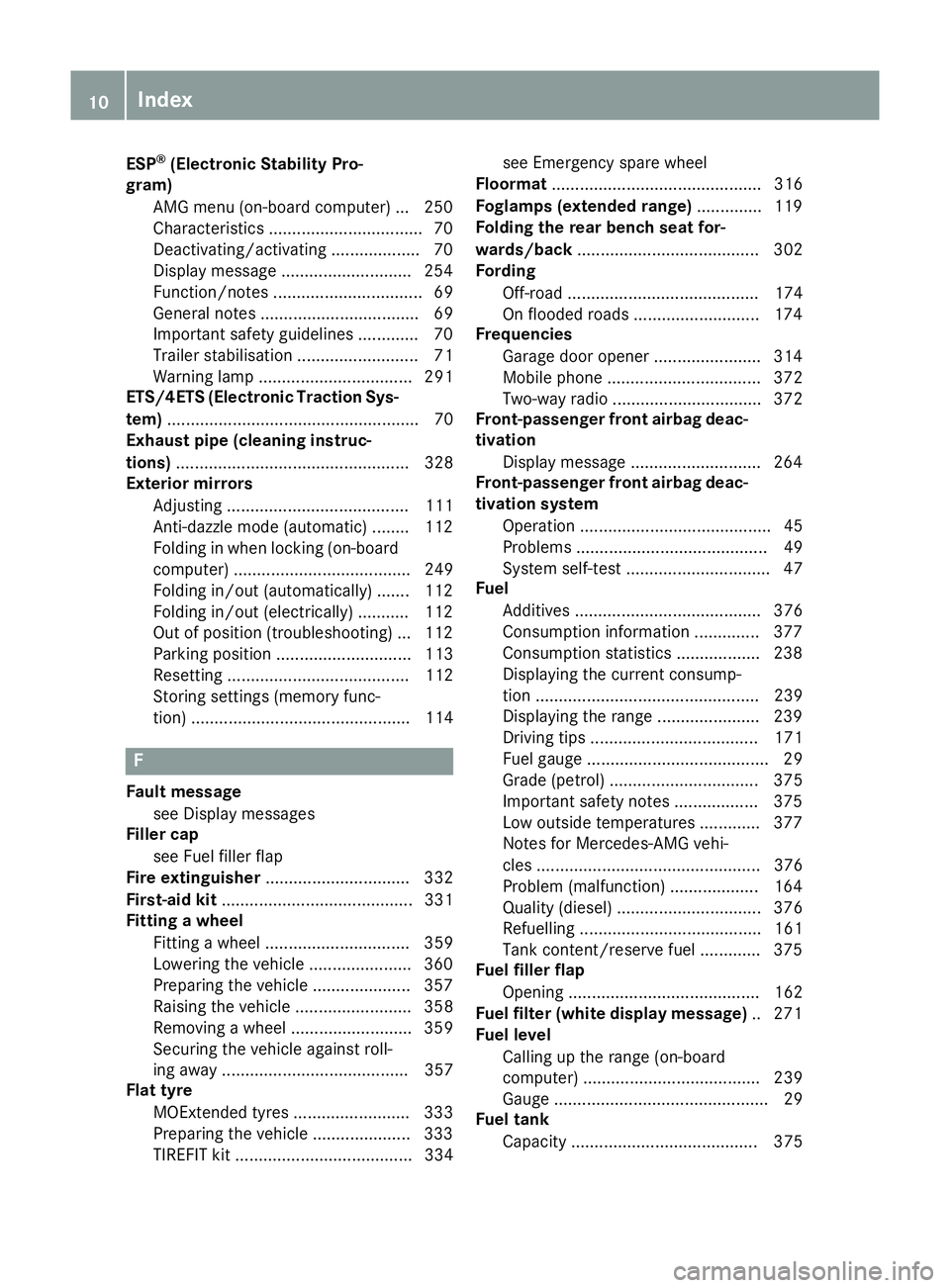
ESP
®
(Electronic Stability Pro-
gram)
AMG menu (on-board computer) .. .250
Characteristics ................................. 70
Deactivating/activating ................... 70
Display message ............................ 254
Function/notes ................................ 69
General notes .................................. 69
Important safety guidelines ............. 70
Trailer stabilisatio n.......................... 71
Warning lamp ................................. 291
ETS/4ETS (Electronic Traction Sys-
tem) ...................................................... 70
Exhaust pipe (cleaning instruc-
tions) .................................................. 328
Exterior mirrors
Adjusting ....................................... 111
Anti-dazzle mode (automatic) ........ 112
Folding in when locking (on-board computer) ...................................... 249
Folding in/out (automatically )....... 112
Folding in/out (electrically) ........... 112
Out of position (troubleshooting) ... 112
Parking position ............................. 113
Resetting ....................................... 112
Storing settings (memory func-
tion) ............................................... 114 F
Fault message see Display messages
Filler cap
see Fuel filler flap
Fire extinguisher ............................... 332
First-aid kit ......................................... 331
Fitting a wheel
Fitting a wheel ............................... 359
Lowering the vehicle ...................... 360
Preparing the vehicle ..................... 357
Raising the vehicl e......................... 358
Removing a whee l.......................... 359
Securing the vehicle against roll-
ing away ........................................ 357
Flat tyre
MOExtended tyre s......................... 333
Preparing the vehicle ..................... 333
TIREFIT kit ...................................... 334 see Emergency spare wheel
Floormat ............................................. 316
Foglamps (extended range) .............. 119
Folding the rear bench seat for-
wards/back ....................................... 302
Fording
Off-road ......................................... 174
On flooded roads ........................... 174
Frequencies
Garage door opener ....................... 314
Mobile phone ................................. 372
Two-way radio ................................ 372
Front-passenger front airbag deac-
tivation
Display message ............................ 264
Front-passenger front airbag deac-
tivation system
Operation ......................................... 45
Problems ......................................... 49
System self-test ............................... 47
Fuel
Additives ........................................ 376
Consumption information .............. 377
Consumption statistics .................. 238
Displaying the current consump-
tion ................................................ 239
Displaying the range ...................... 239
Driving tip s.................................... 171
Fuel gauge ....................................... 29
Grade (petrol) ................................ 375
Important safety notes .................. 375
Low outside temperatures ............. 377
Notes for Mercedes ‑AMG vehi-
cles ................................................ 376
Problem (malfunction) ................... 164
Quality (diesel )............................... 376
Refuelling ....................................... 161
Tank content/reserve fue l............. 375
Fuel filler flap
Opening ......................................... 162
Fuel filter (white display message) .. 271
Fuel level
Calling up the range (on-board
computer) ...................................... 239
Gauge .............................................. 29
Fuel tank
Capacity ........................................ 375 10
Index
Page 19 of 393
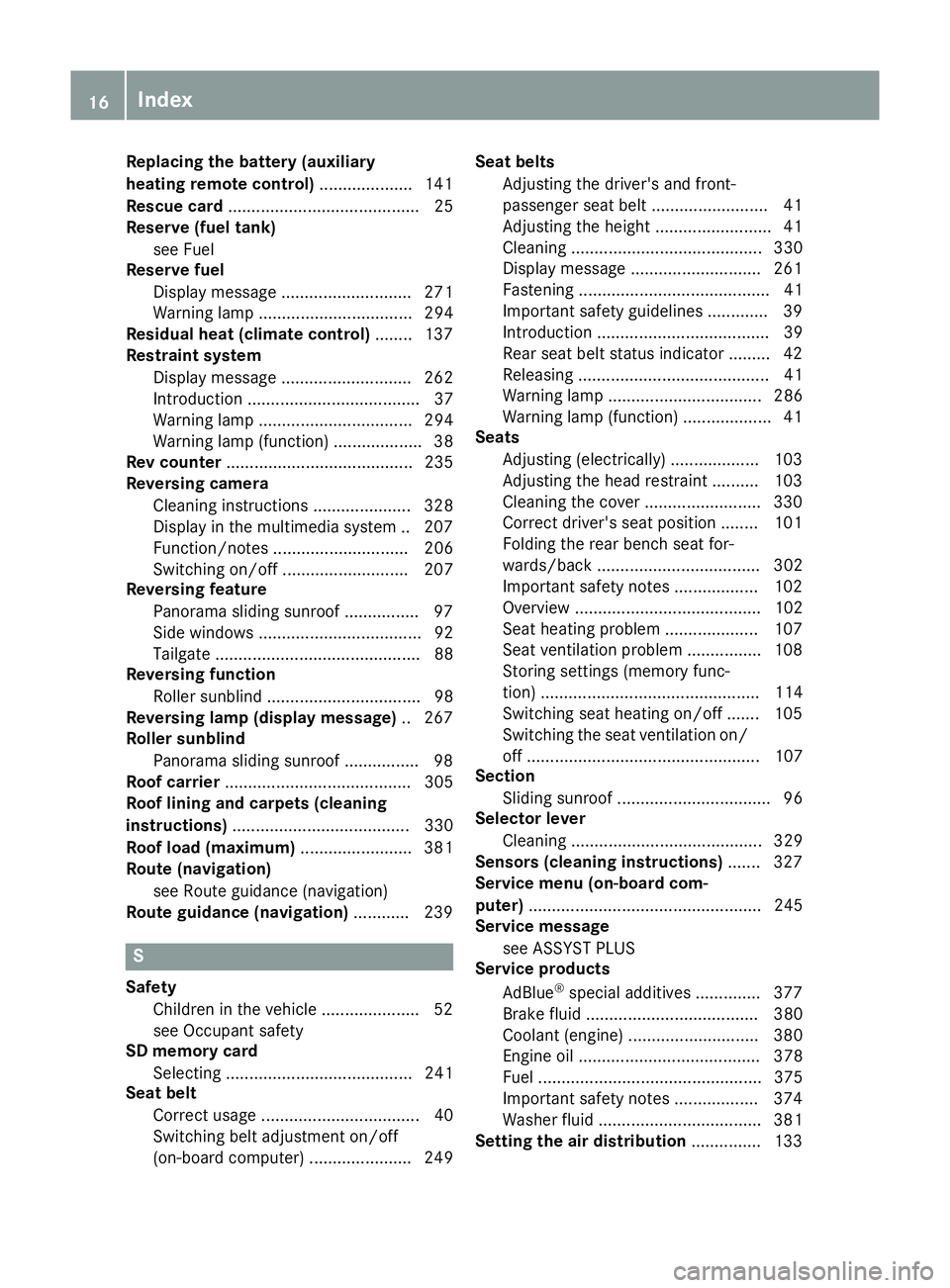
Replacing the battery (auxiliary
heating remote control)
.................... 141
Rescue card ......................................... 25
Reserve (fuel tank)
see Fuel
Reserve fuel
Display messag e............................ 271
Warning lamp ................................. 294
Residual heat (climate control) ........ 137
Restraint system
Display message ............................ 262
Introduction ..................................... 37
Warning lamp ................................. 294
Warning lamp (function) ................... 38
Rev counter ........................................ 235
Reversing camera
Cleaning instructions ..................... 328
Display in the multimedia system .. 207
Function/note s............................. 206
Switching on/of f........................... 207
Reversing feature
Panorama sliding sunroo f................ 97
Side windows ................................... 92
Tailgate ............................................ 88
Reversing function
Roller sunblind ................................. 98
Reversing lamp (display message) .. 267
Roller sunblind
Panorama sliding sunroo f................ 98
Roof carrier ........................................ 305
Roof lining and carpets (cleaning
instructions) ...................................... 330
Roof load (maximum) ........................ 381
Route (navigation)
see Route guidance (navigation)
Route guidance (navigation) ............ 239S
Safety Children in the vehicle ..................... 52
see Occupant safety
SD memory card
Selecting ........................................ 241
Seat belt
Correct usage .................................. 40
Switching belt adjustment on/off
(on-board computer) ...................... 249 Seat belts
Adjusting the driver's and front-
passenger seat belt ......................... 41
Adjusting the height ......................... 41
Cleaning ......................................... 330
Display message ............................ 261
Fastening ......................................... 41
Important safety guidelines ............. 39
Introduction ..................................... 39
Rear seat belt status indicator ......... 42
Releasing ......................................... 41
Warning lamp ................................. 286
Warning lamp (function) ................... 41
Seats
Adjusting (electrically) ................... 103
Adjusting the head restraint .......... 103
Cleaning the cover ......................... 330
Correct driver's seat position ........ 101
Folding the rear bench seat for-
wards/back ................................... 302
Important safety notes .................. 102
Overview ........................................ 102
Seat heating problem .................... 107
Seat ventilation problem ................ 108
Storing settings (memory func-
tion) ............................................... 114
Switching seat heating on/of f....... 105
Switching the seat ventilation on/ off .................................................. 107
Section
Sliding sunroof ................................. 96
Selector lever
Cleaning ......................................... 329
Sensors (cleaning instructions) ....... 327
Service menu (on-board com-
puter) .................................................. 245
Service message
see ASSYST PLUS
Service products
AdBlue ®
special additive s.............. 377
Brake fluid ..................................... 380
Coolant (engine) ............................ 380
Engine oil ....................................... 378
Fuel ................................................ 375
Important safety notes .................. 374
Washer fluid ................................... 381
Setting the air distribution ............... 13316
Index
Page 23 of 393
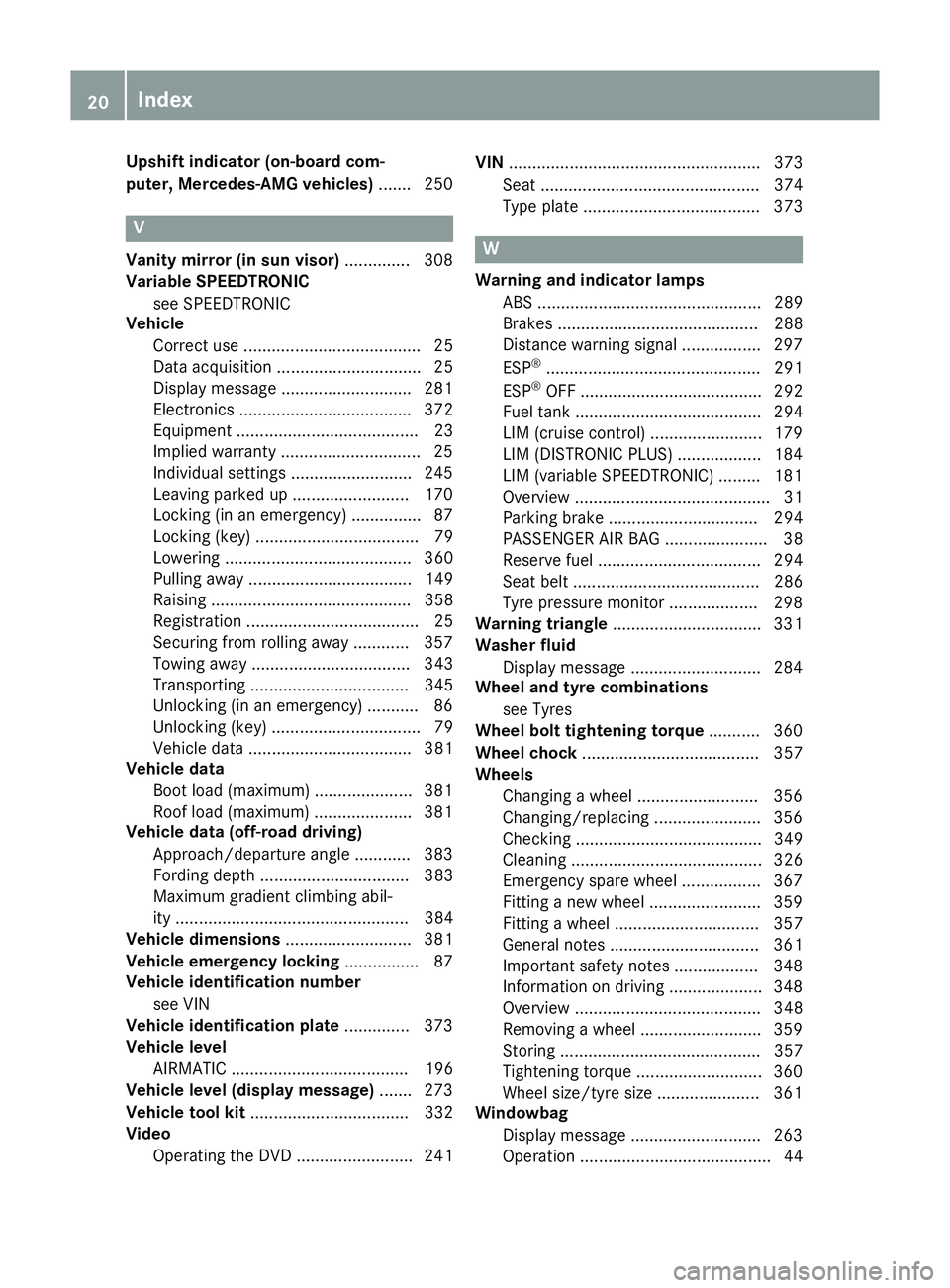
Upshift indicator (on-board com-
puter, Mercedes-AMG vehicles)
.......250 V
Vanity mirror (in sun visor) .............. 308
Variable SPEEDTRONIC
see SPEEDTRONIC
Vehicle
Correct use ...................................... 25
Data acquisition ............................... 25
Display message ............................ 281
Electronics ..................................... 372
Equipment ....................................... 23
Implied warranty .............................. 25
Individual settings .......................... 245
Leaving parked up ......................... 170
Locking (in an emergency) .............. .87
Locking (key) ................................... 79
Lowering ........................................ 360
Pulling away ................................... 149
Raising ........................................... 358
Registration ..................................... 25
Securing from rolling away ............ 357
Towing away .................................. 343
Transporting .................................. 345
Unlocking (in an emergency) ........... 86
Unlocking (key) ................................ 79
Vehicle data ................................... 381
Vehicle data
Boot load (maximum) ..................... 381
Roof load (maximum) ..................... 381
Vehicle data (off-road driving)
Approach/departure angle ............ 383
Fording depth ................................ 383
Maximum gradient climbing abil-
ity .................................................. 384
Vehicle dimensions ........................... 381
Vehicle emergency locking ................ 87
Vehicle identification number
see VIN
Vehicle identification plate .............. 373
Vehicle level
AIRMATIC ...................................... 196
Vehicle level (display message) ....... 273
Vehicle tool kit .................................. 332
Video
Operating the DVD ......................... 241 VIN
...................................................... 373
Seat ............................................... 374
Type plate ...................................... 373 W
Warning and indicator lamps ABS ................................................ 289
Brakes ........................................... 288
Distance warning signal ................. 297
ESP ®
.............................................. 291
ESP ®
OFF ....................................... 292
Fuel tank ........................................ 294
LIM (cruise control) ........................ 179
LIM (DISTRONIC PLUS) .................. 184
LIM (variable SPEEDTRONIC) ......... 181
Overview .......................................... 31
Parking brake ................................ 294
PASSENGER AIR BAG ...................... 38
Reserve fue l................................... 294
Seat belt ........................................ 286
Tyre pressure monitor ................... 298
Warning triangle ................................ 331
Washer fluid
Display message ............................ 284
Wheel and tyre combinations
see Tyres
Wheel bolt tightening torque ........... 360
Wheel chock ...................................... 357
Wheels
Changing a whee l.......................... 356
Changing/replacing ....................... 356
Checking ........................................ 349
Cleaning ......................................... 326
Emergency spare whee l................. 367
Fitting a new wheel ........................ 359
Fitting a wheel ............................... 357
General notes ................................ 361
Important safety notes .................. 348
Information on driving .................... 348
Overview ........................................ 348
Removing a whee l.......................... 359
Storing ........................................... 357
Tightening torque ........................... 360
Wheel size/tyre size ...................... 361
Windowbag
Display message ............................ 263
Operation ......................................... 44 20
Index
Page 34 of 393
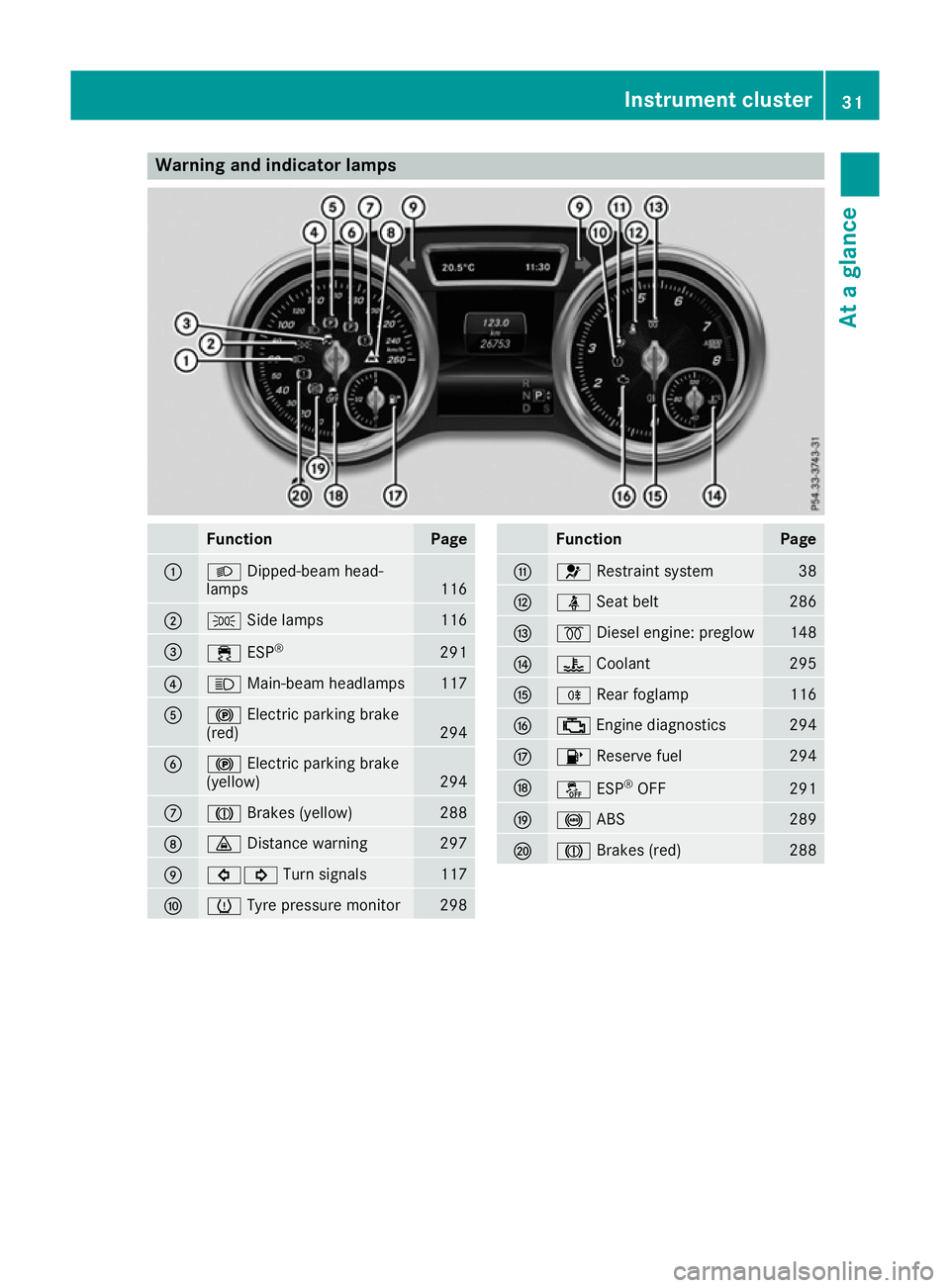
Warning and indicator lamps
Function Page
:
L
Dipped-beam head-
lamps 116
;
T
Side lamps 116
=
÷
ESP® 291
?
K
Main-beam headlamps 117
A
!
Electric parking brake
(red) 294
B
!
Electric parking brake
(yellow) 294
C
J
Brakes (yellow) 288
D
·
Distance warning 297
E
#!
Turn signals 117
F
h
Tyre pressure monitor 298 Function Page
G
6
Restraint system 38
H
ü
Seat belt 286
I
%
Diesel engine: preglow 148
J
?
Coolant 295
K
R
Rear foglamp 116
L
;
Engine diagnostics 294
M
8
Reserve fuel 294
N
å
ESP®
OFF 291
O
!
ABS 289
P
J
Brakes (red) 288Instrument cluster
31At a glance
Page 141 of 393
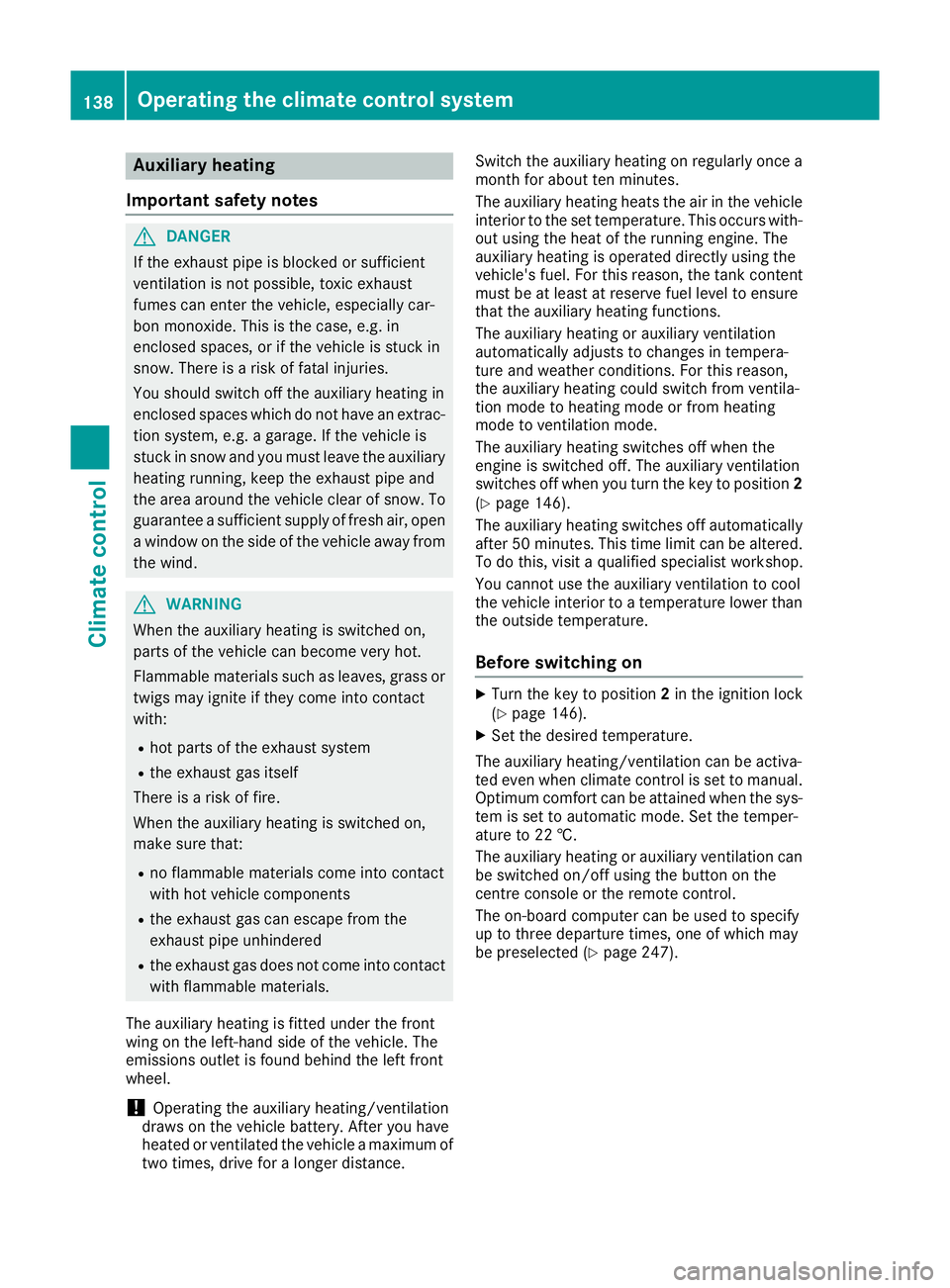
Auxiliary heating
Important safety notes G
DANGER
If the exhaust pipe is blocked or sufficient
ventilation is not possible, toxic exhaust
fumes can enter the vehicle, especially car-
bon monoxide. This is the case, e.g. in
enclosed spaces, or if the vehicle is stuck in
snow. There is a risk of fatal injuries.
You should switch off the auxiliary heating in
enclosed spaces which do not have an extrac- tion system, e.g. a garage. If the vehicle is
stuck in snow and you must leave the auxiliary
heating running, keep the exhaust pipe and
the area around the vehicle clear of snow. To guarantee a sufficient supply of fresh air, open
a window on the side of the vehicle away from the wind. G
WARNING
When the auxiliary heating is switched on,
parts of the vehicle can become very hot.
Flammable materials such as leaves, grass or twigs may ignite if they come into contact
with:
R hot parts of the exhaust system
R the exhaust gas itself
There is a risk of fire.
When the auxiliary heating is switched on,
make sure that:
R no flammable materials come into contact
with hot vehicle components
R the exhaust gas can escape from the
exhaust pipe unhindered
R the exhaust gas does not come into contact
with flammable materials.
The auxiliary heating is fitted under the front
wing on the left-hand side of the vehicle. The
emissions outlet is found behind the left front
wheel.
! Operating the auxiliary heating/ventilation
draws on the vehicle battery. After you have
heated or ventilated the vehicle a maximum of two times, drive for a longer distance. Switch the auxiliary heating on regularly once a
month for about ten minutes.
The auxiliary heating heats the air in the vehicle
interior to the set temperature. This occurs with- out using the heat of the running engine. The
auxiliary heating is operated directly using the
vehicle's fuel. For this reason, the tank content
must be at least at reserve fuel level to ensure
that the auxiliary heating functions.
The auxiliary heating or auxiliary ventilation
automatically adjusts to changes in tempera-
ture and weather conditions. For this reason,
the auxiliary heating could switch from ventila-
tion mode to heating mode or from heating
mode to ventilation mode.
The auxiliary heating switches off when the
engine is switched off. The auxiliary ventilation
switches off when you turn the key to position 2
(Y page 146).
The auxiliary heating switches off automatically after 50 minute s.This time limit can be altered.
To do this, visit a qualified specialist workshop.
You cannot use the auxiliary ventilation to cool
the vehicle interior to a temperature lower than
the outside temperature.
Before switching on X
Turn the key to position 2in the ignition lock
(Y page 146).
X Set the desired temperature.
The auxiliary heating/ventilation can be activa-
ted even when climate control is set to manual.
Optimum comfort can be attained when the sys-
tem is set to automatic mode. Set the temper-
ature to 22 †.
The auxiliary heating or auxiliary ventilation can
be switched on/off using the button on the
centre console or the remote control.
The on-board computer can be used to specify
up to three departure times, one of which may
be preselected (Y page 247).138
Operating the climate control systemClimate control
Page 145 of 393
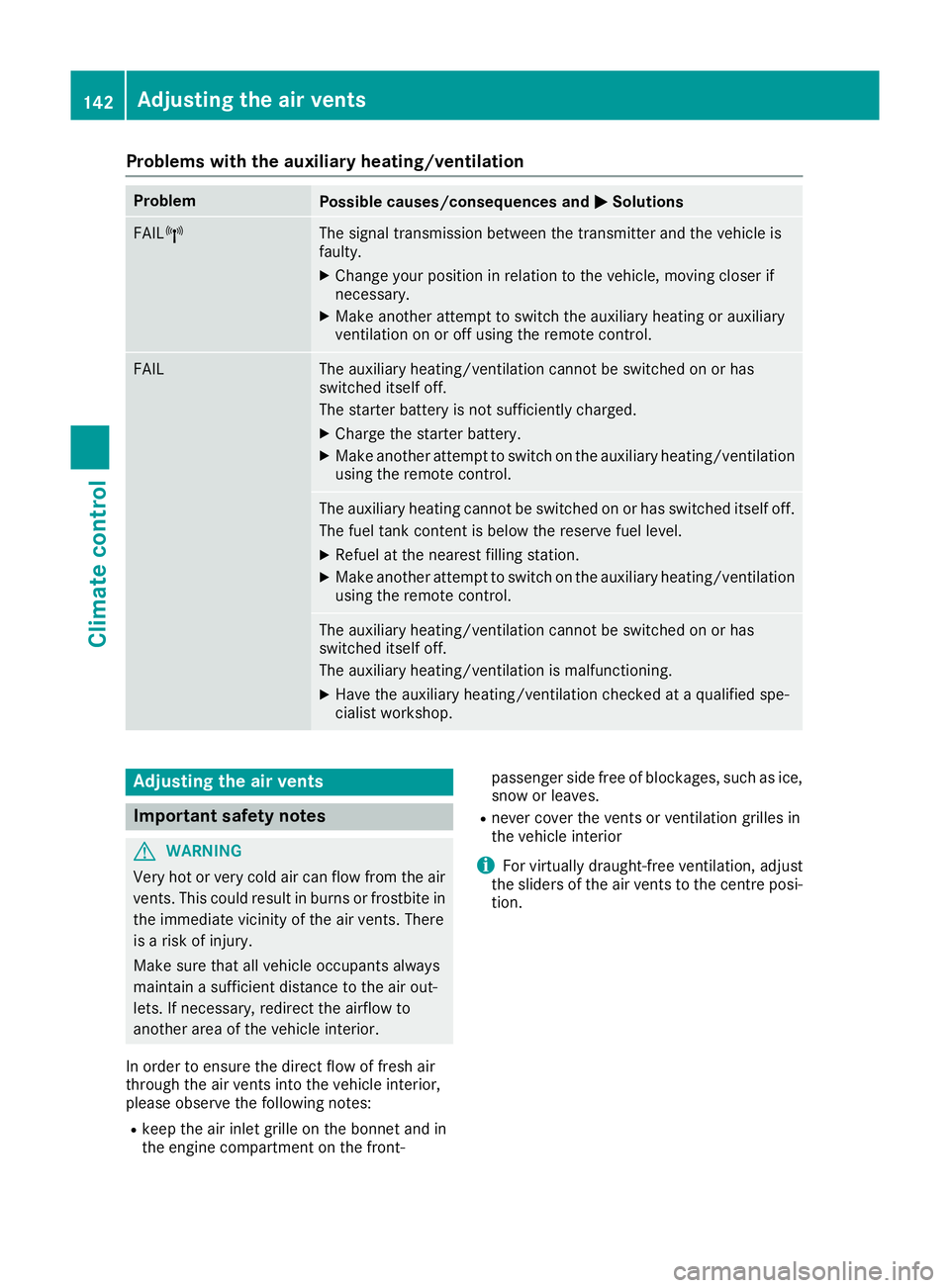
Problems with the auxiliary heating/ventilation
Problem
Possible causes/consequences and
M
MSolutions FAIL¨ The signal transmission between the transmitter and the vehicle is
faulty.
X
Change your position in relation to the vehicle, moving closer if
necessary.
X Make another attempt to switch the auxiliary heating or auxiliary
ventilation on or off using the remote control. FAIL The auxiliary heating/ventilation cannot be switched on or has
switched itself off.
The starter battery is not sufficiently charged.
X Charge the starter battery.
X Make another attempt to switch on the auxiliary heating/ventilation
using the remote control. The auxiliary heating cannot be switched on or has switched itself off.
The fuel tank content is below the reserve fuel level.
X Refuel at the nearest filling station.
X Make another attempt to switch on the auxiliary heating/ventilation
using the remote control. The auxiliary heating/ventilation cannot be switched on or has
switched itself off.
The auxiliary heating/ventilation is malfunctioning.
X Have the auxiliary heating/ventilation checked at a qualified spe-
cialist workshop. Adjusting the air vents
Important safety notes
G
WARNING
Very hot or very cold air can flow from the air vents. This could result in burns or frostbite in the immediate vicinity of the air vents. There
is a risk of injury.
Make sure that all vehicle occupants always
maintain a sufficient distance to the air out-
lets. If necessary, redirect the airflow to
another area of the vehicle interior.
In order to ensure the direct flow of fresh air
through the air vents into the vehicle interior,
please observe the following notes:
R keep the air inlet grille on the bonnet and in
the engine compartment on the front- passenger side free of blockages, such as ice,
snow or leaves.
R never cover the vents or ventilation grilles in
the vehicle interior
i For virtually draught-free ventilation, adjust
the sliders of the air vents to the centre posi- tion. 142
Adjusting the air ventsClimate control
Page 155 of 393
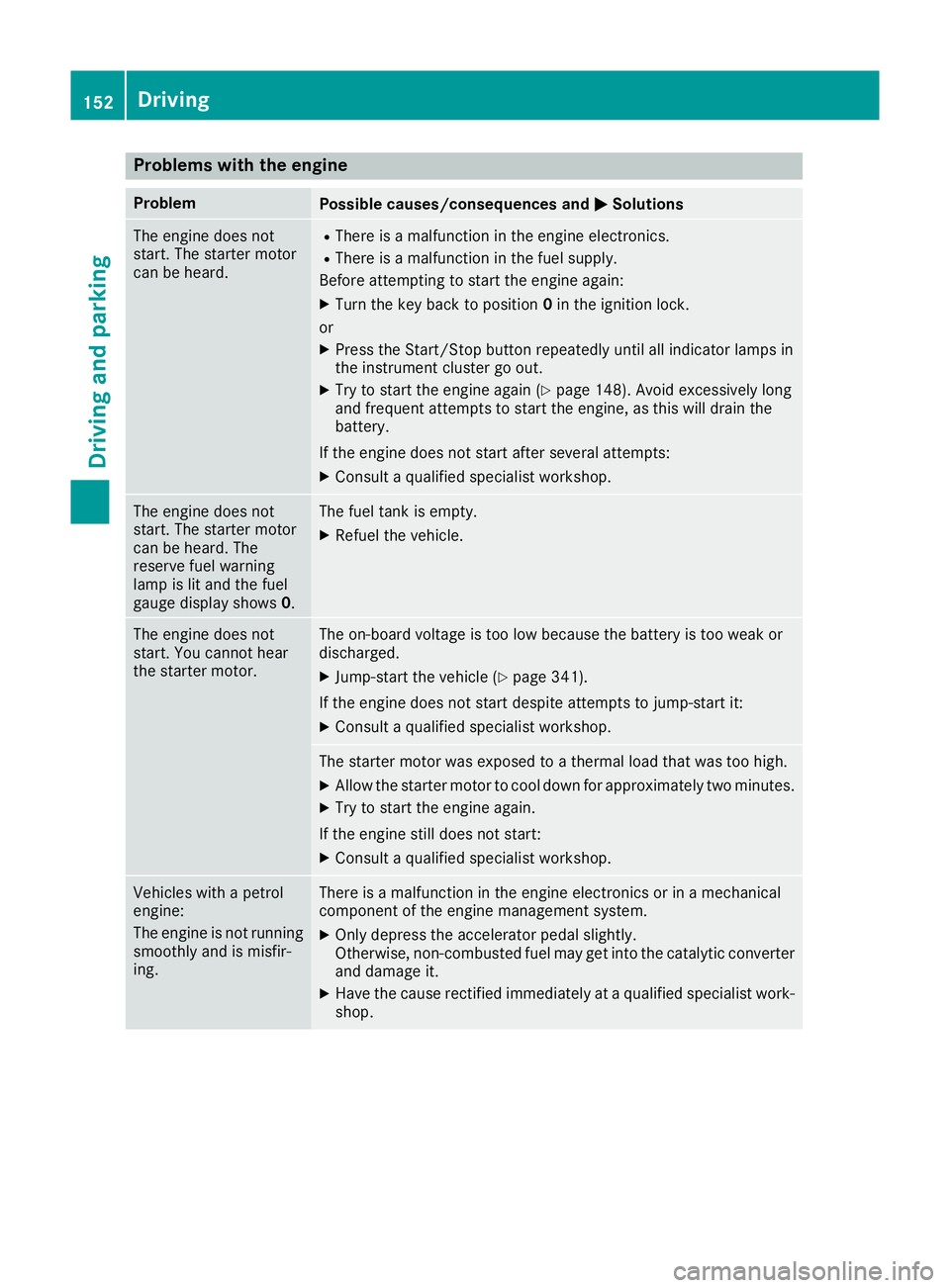
Problems with the engine
Problem
Possible causes/consequences and
M
MSolutions The engine does not
start. The starter motor
can be heard. R
There is a malfunction in the engine electronics.
R There is a malfunction in the fuel supply.
Before attempting to start the engine again:
X Turn the key back to position 0in the ignition lock.
or X Press the Start/Stop button repeatedly until all indicator lamps in
the instrument cluster go out.
X Try to start the engine again (Y page 148). Avoid excessively long
and frequent attempts to start the engine, as this will drain the
battery.
If the engine does not start after several attempts:
X Consult a qualified specialist workshop. The engine does not
start. The starter motor
can be heard. The
reserve fuel warning
lamp is lit and the fuel
gauge display shows
0. The fuel tank is empty.
X Refuel the vehicle. The engine does not
start. You cannot hear
the starter motor. The on-board voltage is too low because the battery is too weak or
discharged.
X Jump-start the vehicle (Y page 341).
If the engine does not start despite attempts to jump-start it:
X Consult a qualified specialist workshop. The starter motor was exposed to a thermal load that was too high.
X Allow the starter motor to cool down for approximately two minutes.
X Try to start the engine again.
If the engine still does not start: X Consult a qualified specialist workshop. Vehicles with a petrol
engine:
The engine is not running
smoothly and is misfir-
ing. There is a malfunction in the engine electronics or in a mechanical
component of the engine management system.
X Only depress the accelerator pedal slightly.
Otherwise, non-combusted fuel may get into the catalytic converter
and damage it.
X Have the cause rectified immediately at a qualified specialist work-
shop. 152
DrivingDriving and parking
Page 174 of 393
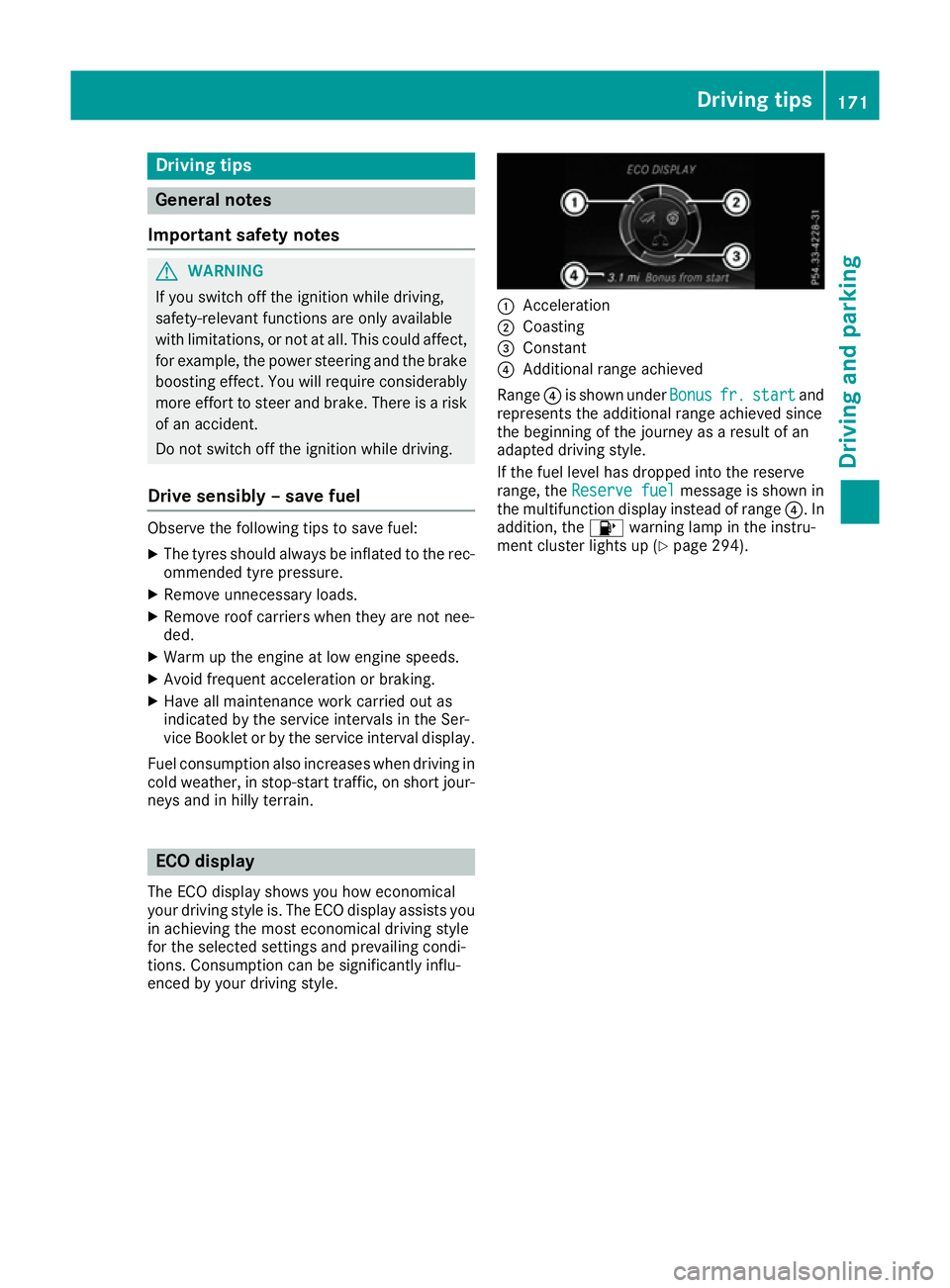
Driving tips
General notes
Important safety notes G
WARNING
If you switch off the ignition while driving,
safety-relevant functions are only available
with limitations, or not at all. This could affect, for example, the power steering and the brake
boosting effect. You will require considerably
more effort to steer and brake. There is a risk of an accident.
Do not switch off the ignition while driving.
Drive sensibly – save fuel Observe the following tips to save fuel:
X The tyres should always be inflated to the rec-
ommended tyre pressure.
X Remove unnecessary loads.
X Remove roof carriers when they are not nee-
ded.
X Warm up the engine at low engine speeds.
X Avoid frequent acceleration or braking.
X Have all maintenance work carried out as
indicated by the service intervals in the Ser-
vice Booklet or by the service interval display.
Fuel consumption also increases when driving in
cold weather, in stop-start traffic, on short jour- neys and in hilly terrain. ECO display
The ECO display shows you how economical
your driving style is. The ECO display assists you in achieving the most economical driving style
for the selected settings and prevailing condi-
tions. Consumption can be significantly influ-
enced by your driving style. :
Acceleration
; Coasting
= Constant
? Additional range achieved
Range ?is shown under Bonus Bonusfr.
fr.start
start and
represents the additional range achieved since
the beginning of the journey as a result of an
adapted driving style.
If the fuel level has dropped into the reserve
range, the Reserve fuel
Reserve fuel message is shown in
the multifunction display instead of range ?. In
addition, the 8warning lamp in the instru-
ment cluster lights up (Y page 294). Driving tips
171Driving and pa rking Z